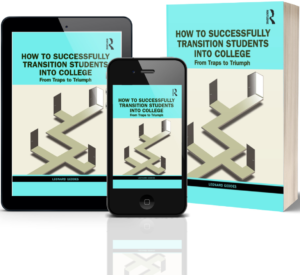[et_pb_section fb_built=”1″ admin_label=”section” _builder_version=”4.16″ global_colors_info=”{}”][et_pb_row admin_label=”row” _builder_version=”4.16″ background_size=”initial” background_position=”top_left” background_repeat=”repeat” global_colors_info=”{}”][et_pb_column type=”4_4″ _builder_version=”4.16″ custom_padding=”|||” global_colors_info=”{}” custom_padding__hover=”|||”][et_pb_text _builder_version=”4.22.1″ _module_preset=”default” global_colors_info=”{}”]
Colleges and universities face a range of challenges, such as retaining new students, ensuring returning students make satisfactory progress, and maintaining high academic standards, all while achieving high levels of community satisfaction. These challenges may sometimes appear to be in conflict, pulling us in myriad directions. However, this short post shares a common thread throughout them.
The essence of effective problem-solving lies in clarity. Charles Kettering, a distinguished inventor with over 185 patents, once said, “A problem well-stated is half-solved.” This principle is also recognized in academic research, where clearly defining the problem is often the most significant hurdle.
From my experience, the key to overcoming student success challenges is a deep understanding of the fundamental, universal challenge: How can we empower students to make the right contributions to their academic work? Answering this seemingly simple question addresses the performance issues students, educators, and institutions face. Yet, it’s a question that is often overlooked or misunderstood.
When we attend conferences, it is tempting to become overwhelmed by a buffet of solutions. However, there are so many solutions because we don’t fully understand the problem. As Malcolm Forbes pointedly observed, it’s much easier to suggest solutions when you’re not fully aware of the problem. To effectively address underperformance, we must first understand the core challenge at its heart.
 In How to Successfully Transition Students into College: From Traps to Triumph, I delve into the issue of college underperformance, steering clear of negative narratives that lead nowhere. The book empathetically considers the experiences of high school graduates and teachers, along with college students, educators, and administrators, offering a balanced perspective that is refreshingly rare.
In How to Successfully Transition Students into College: From Traps to Triumph, I delve into the issue of college underperformance, steering clear of negative narratives that lead nowhere. The book empathetically considers the experiences of high school graduates and teachers, along with college students, educators, and administrators, offering a balanced perspective that is refreshingly rare.
You can preview the introduction for free from the publisher’s site, Routledge Press.
To really solve problems, we must fully understand them. Here are three ponderings that helped me gain clarity:
- What is the real, universal problem? Every institution, whether Ivy League or open access, enrolls students with the expectation of success. Regardless of how hard students and educators work, academic success hinges on each student making the proper contributions to their work.
- How can this problem be succinctly stated? Articulating the problem in a single sentence may require time and understanding essential constructs, which I outline in the “Research Cocktail” section of my book’s introduction, available on the publisher’s website. The question we must grapple with here is the sequential effect of the constructs. I had to go through the darkness of complexity to get to a place of simplicity’s light. You may have to travel this path as well.
- How can we solve this problem with the resources we have? Institutions often have the means to solve their problems internally without new gadgetry. Surprisingly, internal tools and leaders will emerge once you thoroughly understand the problem.
The danger of not getting clarity is significant.
When the problem is poorly understood, “solutions” often spawn new problems, leading to a cycle of unnecessary work without resolving the core issue. Instead of succumbing to an endless cycle of new gadgets and “innovations,” we can and must do better. Better ultimately comes down to how we answer this question.
How can we empower students to make the right contributions to their academic work?
Free exchange
I would like to invite you to sample my free canvas course, GPS: Learning, which I am creating to help institutions empower learning center professionals and peers to lift their institutions to greater levels of academic success. These services have a uniquely powerful role in college academic work. Yet, their impact is often limited. This course will empower them to serve more effectively.
I only ask that you complete the survey at the end so that we can make this course as useful as possible for you.
Enroll for free by clicking the following button.
[button link=”https://canvas.instructure.com/enroll/KYFC79″ type=”big” newwindow=”yes”] GPS Learning Sample Course[/button]
[/et_pb_text][/et_pb_column][/et_pb_row][/et_pb_section]

